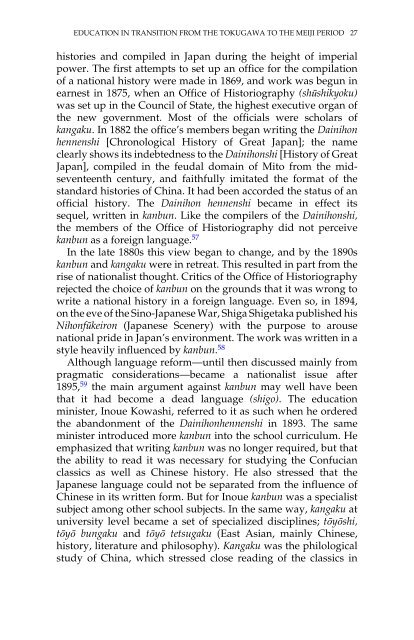Private Academies of Chinese Learning in Meiji Japan: The Decline ...
Private Academies of Chinese Learning in Meiji Japan: The Decline ...
Private Academies of Chinese Learning in Meiji Japan: The Decline ...
You also want an ePaper? Increase the reach of your titles
YUMPU automatically turns print PDFs into web optimized ePapers that Google loves.
EDUCATION IN TRANSITION FROM THE TOKUGAWA TO THE MEIJI PERIOD 27histories and compiled <strong>in</strong> <strong>Japan</strong> dur<strong>in</strong>g the height <strong>of</strong> imperialpower. <strong>The</strong> first attempts to set up an <strong>of</strong>fice for the compilation<strong>of</strong> a national history were made <strong>in</strong> 1869, and work was begun <strong>in</strong>earnest <strong>in</strong> 1875, when an Office <strong>of</strong> Historiography (shūshikyoku)was set up <strong>in</strong> the Council <strong>of</strong> State, the highest executive organ <strong>of</strong>the new government. Most <strong>of</strong> the <strong>of</strong>ficials were scholars <strong>of</strong>kangaku. In 1882 the <strong>of</strong>fice’s members began writ<strong>in</strong>g the Da<strong>in</strong>ihonhennenshi [Chronological History <strong>of</strong> Great <strong>Japan</strong>]; the nameclearly shows its <strong>in</strong>debtedness to the Da<strong>in</strong>ihonshi [History <strong>of</strong> Great<strong>Japan</strong>], compiled <strong>in</strong> the feudal doma<strong>in</strong> <strong>of</strong> Mito from the midseventeenthcentury, and faithfully imitated the format <strong>of</strong> thestandard histories <strong>of</strong> Ch<strong>in</strong>a. It had been accorded the status <strong>of</strong> an<strong>of</strong>ficial history. <strong>The</strong> Da<strong>in</strong>ihon hennenshi became <strong>in</strong> effect itssequel, written <strong>in</strong> kanbun. Like the compilers <strong>of</strong> the Da<strong>in</strong>ihonshi,the members <strong>of</strong> the Office <strong>of</strong> Historiography did not perceivekanbun as a foreign language. 57In the late 1880s this view began to change, and by the 1890skanbun and kangaku were <strong>in</strong> retreat. This resulted <strong>in</strong> part from therise <strong>of</strong> nationalist thought. Critics <strong>of</strong> the Office <strong>of</strong> Historiographyrejected the choice <strong>of</strong> kanbun on the grounds that it was wrong towrite a national history <strong>in</strong> a foreign language. Even so, <strong>in</strong> 1894,on the eve <strong>of</strong> the S<strong>in</strong>o-<strong>Japan</strong>ese War, Shiga Shigetaka published hisNihonfūkeiron (<strong>Japan</strong>ese Scenery) with the purpose to arousenational pride <strong>in</strong> <strong>Japan</strong>’s environment. <strong>The</strong> work was written <strong>in</strong> astyle heavily <strong>in</strong>fluenced by kanbun. 58Although language reform—until then discussed ma<strong>in</strong>ly frompragmatic considerations—became a nationalist issue after1895, 59 the ma<strong>in</strong> argument aga<strong>in</strong>st kanbun may well have beenthat it had become a dead language (shigo). <strong>The</strong> educationm<strong>in</strong>ister, Inoue Kowashi, referred to it as such when he orderedthe abandonment <strong>of</strong> the Da<strong>in</strong>ihonhennenshi <strong>in</strong> 1893. <strong>The</strong> samem<strong>in</strong>ister <strong>in</strong>troduced more kanbun <strong>in</strong>to the school curriculum. Heemphasized that writ<strong>in</strong>g kanbun was no longer required, but thatthe ability to read it was necessary for study<strong>in</strong>g the Confucianclassics as well as <strong>Ch<strong>in</strong>ese</strong> history. He also stressed that the<strong>Japan</strong>ese language could not be separated from the <strong>in</strong>fluence <strong>of</strong><strong>Ch<strong>in</strong>ese</strong> <strong>in</strong> its written form. But for Inoue kanbun was a specialistsubject among other school subjects. In the same way, kangaku atuniversity level became a set <strong>of</strong> specialized discipl<strong>in</strong>es; tōyōshi,tōyō bungaku and tōyō tetsugaku (East Asian, ma<strong>in</strong>ly <strong>Ch<strong>in</strong>ese</strong>,history, literature and philosophy). Kangaku was the philologicalstudy <strong>of</strong> Ch<strong>in</strong>a, which stressed close read<strong>in</strong>g <strong>of</strong> the classics <strong>in</strong>













